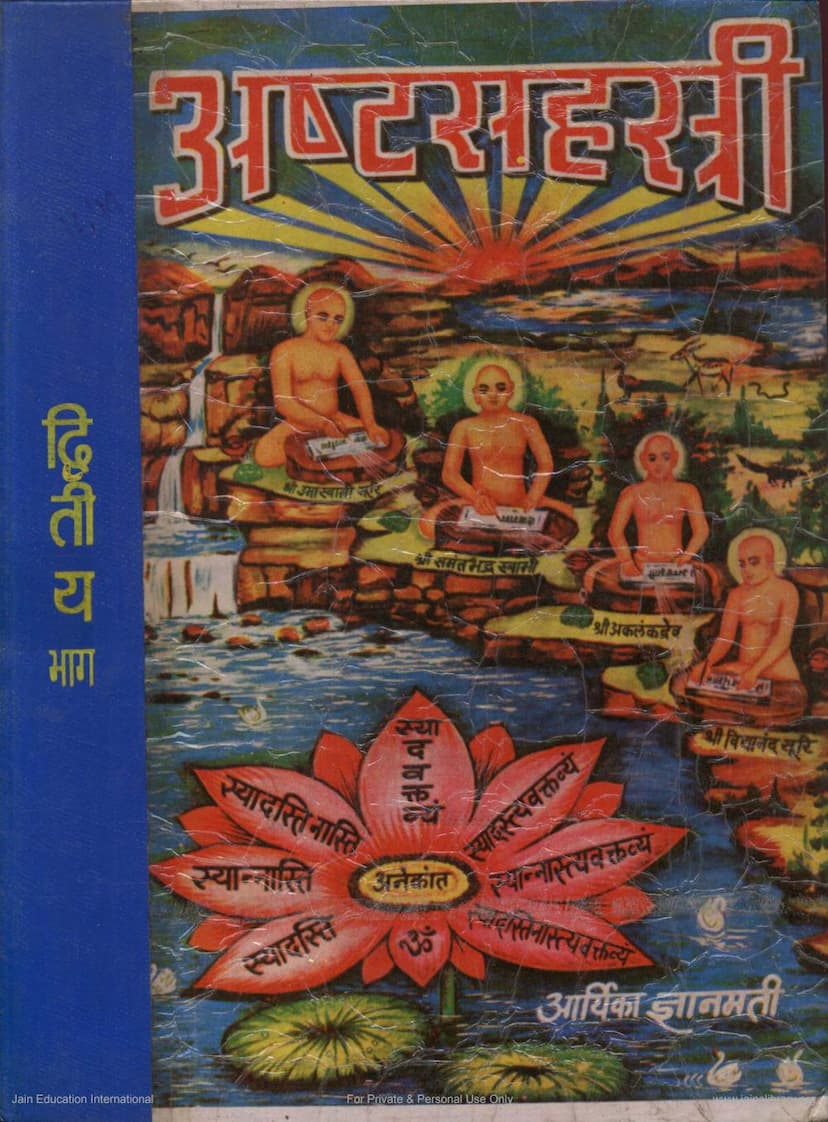Ashtsahastri Part 2
Added to library: September 1, 2025

Summary
This is a comprehensive summary of the Jain text "Ashtasahastri Part 2" by Vidyanandacharya and Gyanmati Mataji, based on the provided catalog link and partial text.
Book Title: Ashtasahastri Part 2 Author(s): Vidyanandacharya, Gyanmati Mataji Publisher: Digambar Jain Trilok Shodh Sansthan Catalog Link: https://jainqq.org/explore/001549/1
Overall Summary:
Ashtasahastri Part 2, the second volume of Ashtasahastri, is a significant work in Jain philosophy, specifically in the realm of Jain logic and epistemology (Nayavada and Syadvada). Authored by the esteemed Vidyanandacharya and presented with a commentary by Aryika Gyanmati Mataji, this book delves deep into the refutation of various non-Jain philosophical viewpoints and establishes the Jain perspective on reality, particularly through the lens of the Syadvada doctrine and its famous Saptabhangi (seven-fold predication).
The text meticulously analyzes and critiques the philosophies of various schools, including Buddhism (Madhyamaka, Vijnyanvada), Samkhya, Nyaya, Mimamsa, and Charvaka. It addresses fundamental ontological questions regarding the nature of reality, existence, non-existence, causality, and knowledge.
Key Themes and Concepts Covered (as indicated by the detailed index and excerpts):
The comprehensive subject index (विषय दर्पण) provided in the text outlines the vast scope of Ashtasahastri Part 2. It covers an extensive range of philosophical debates and refutations of opposing views. Here's a breakdown of the major themes:
- Refutation of Monistic and Ekantavada (One-sided) Views: A central theme is the critique of philosophies that assert reality is exclusively existent (Asti), exclusively non-existent (Nasti), exclusively describable (Vachya), exclusively indescribable (Avachya), exclusively one (Eka), or exclusively many (Anek). Jainism, through Syadvada, asserts that reality is multifaceted and can be understood from multiple perspectives.
- Saptabhangi (Seven-fold Predication): The text elaborates on the Syadvada doctrine, particularly the Saptabhangi, which states that any statement about reality is conditional and can be expressed in seven different ways (Syadasti, Syannasti, Syadastinasti, Syadvaktavyam, Syadastiavaktavyam, Syannastiavaktavyam, Syadastinastiavaktavyam). This doctrine is used to explain the complexity and relational nature of reality, avoiding one-sided assertions.
- Analysis of Pramanas (Means of Valid Knowledge): The book likely discusses various pramanas recognized in Indian philosophy, such as Perception (Pratyaksha), Inference (Anumana), and Testimony (Agama), and how Jainism interprets and utilizes them, especially in understanding the nature of reality and refuting erroneous views.
- Critique of Causality and Origination: The text likely engages with different theories of causation, discussing concepts like Prāgabhāva (antecedent non-existence) and Dhvansābhāva (subsequent non-existence), refuting views that deny or misinterpret these.
- Debates on the Nature of Soul and Consciousness: The book addresses the nature of the soul (Jiva), consciousness, and the relationship between the soul and matter (Pudgala). It refutes views that deny the soul's existence (Nairatmya) or attribute consciousness to matter.
- Refutation of Specific Philosophical Schools:
- Buddhism: Extensive refutations of Buddhist concepts like Anatmavada (non-soul), Sunyavada (voidness), Khyānavāda (momentariness), and the nature of perception and inference as understood by Buddhist logicians like Dignaga and Dharmakirti.
- Samkhya: Critiques of Samkhya's dualism of Purusha (consciousness) and Prakriti (matter), its theory of evolution (Prakriti Parinama), and its views on liberation.
- Nyaya: Engagement with Nyaya's theories on perception, inference, and the nature of substances and qualities.
- Mimamsa: Refutations of Mimamsa's theories on the eternality of sound (Shabda Nityatva) and the role of rituals.
- Charvaka: Debates with Charvaka materialism and its denial of the afterlife, karma, and other spiritual concepts.
- Brahma Advaita: Refutation of the non-dualistic Advaita Vedanta philosophy, which posits a single, undifferentiated reality (Brahman).
- The Concept of Anekanta (Non-absolutism): This fundamental Jain principle is interwoven throughout the text, used as the basis for understanding reality and resolving philosophical contradictions.
- Detailed Examination of Specific Logical Concepts: The index points to discussions on:
- Itaresvara (mutual non-existence) and Atyantābhāva (absolute non-existence).
- Anvaya (concomitance) and Vyatireka (dissociation) in inferential reasoning.
- The concept of 'Nigrahasthana' (fallacies in debate) as understood by Buddhist logicians.
- The nature of Nayas (standpoints) and their application in understanding reality.
- The reality of sound (Shabda) and its relation to matter (Pudgala) versus it being an attribute of Ākāśa (space).
Significance of Ashtasahastri:
Ashtasahastri is considered a seminal work in Jain logic, acting as an extensive commentary on Bhattakalankadeva's "Ashtashati," which itself is a commentary on Samantabhadra's "Aptamimamsa" (also known as "Devāgama Stotra"). Vidyanandacharya's "Ashtasahastri" is renowned for its depth, clarity, and rigorous logical argumentation, making it a cornerstone for understanding Jain philosophical tenets. The commentary by Aryika Gyanmati Mataji makes this complex text more accessible and relevant to contemporary readers.
In essence, Ashtasahastri Part 2 is a profound philosophical treatise that aims to establish the validity and superiority of the Jain perspective by systematically deconstructing and refuting alternative philosophical systems, all while championing the all-encompassing and non-contradictory principles of Anekanta and Syadvada.